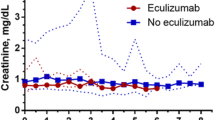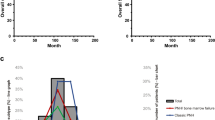Abstract
Although all patients with paroxysmal nocturnal hemoglobinuria (PNH) have acquired mutations in the phosphatidylinositol glycan class-A(PIG-A)gene, their clinical courses are highly variable. We reviewed 280 PNH cases referred to our hospital from January 1990 through June 2010 to assess clinical presentations, prognostic factors influencing survival, difference among subcategories, and clinical significance of PNH clone size. The overall survival at 10 years after diagnosis estimated by Kaplan–Meier was 77.6%. Both univariate and multivariate analyses identified risk factors affecting survival, including age >40 years, absolute neutrophil count<0.5 × 109 cells/L, development of thrombotic events, evolution to myelodysplastic syndrome or acute myelogenous leukemia, and recurrent infections. The cohort of patients were divided into subcategories of classic PNH, PNH/AA, and PNH-sc/AA based on the recent proposed PNH working clinical classification, hemoglobinuria as the initial symptomatic manifestation was high up to 82.0% in classic PNH subcategory, whereas only as low as 1.4% in PNH-sc/AA subcategory; the frequencies of infectious (26.0%) and bleeding symptoms (14.0%) in classic PNH subcategory were significantly less than those in PNH/AA (25.3% and 51.7%, respectively) and PNH-sc/AA (48.3% and 83.2%, respectively) subcategories. Our results revealed that large PNH clone was associated with increased risks for hemoglobinuria and thrombosis, whereas small PNH clone was associated with bone marrow failure. Thus, this study may shed insights into Chinese PNH patients to set up individually therapeutic regimens.


Similar content being viewed by others
References
Hillmen P, Lewis SM, Bessler M, Luzzatto L, Dacie JV (1995) Natural history of paroxysmal nocturnal hemoglobinuria. N Engl J Med 333:1253–1258
Socie G, Mary JY, de Gramont A, Rio B, Leporrier M, Rose C, Heudier P, Rochant H, Cahn JY, Gluckman E (1996) Paroxysmal nocturnal haemoglobinuria: long-term follow-up and prognostic factors. French Society of Haematology. Lancet 348:573–577
Ware RE, Hall SE, Rosse WF (1991) Paroxysmal nocturnal hemoglobinuria with onset in childhood and adolescence. N Engl J Med 325:991–996
Miyata T, Yamada N, Iida Y, Nishimura J, Takeda J, Kitani T, Kinoshita T (1994) Abnormalities of PIG-A transcripts in granulocytes from patients with paroxysmal nocturnal hemoglobinuria. N Engl J Med 330:249–255
Takeda J, Miyata T, Kawagoe K, Iida Y, Endo Y, Fujita T, Takahashi M, Kitani T, Kinoshita T (1993) Deficiency of the GPI anchor caused by a somatic mutation of the PIG-A gene in paroxysmal nocturnal hemoglobinuria. Cell 73:703–711. doi:https://doi.org/10.1016/0092-8674(93)90250-T
Nishimura J, Kanakura Y, Ware RE, Shichishima T, Nakakuma H, Ninomiya H, Decastro CM, Hall S, Kanamaru A, Sullivan KM et al (2004) Clinical course and flow cytometric analysis of paroxysmal nocturnal hemoglobinuria in the United States and Japan. Medicine (Baltimore) 83:193–207. doi:https://doi.org/10.1097/01.md.0000126763.68170.46
de Latour RP, Mary JY, Salanoubat C, Terriou L, Etienne G, Mohty M, Roth S, de Guibert S, Maury S, Cahn JY et al (2008) Paroxysmal nocturnal hemoglobinuria: natural history of disease subcategories. Blood 112:3099–3106. doi:https://doi.org/10.1182/blood-2008-01-133918
Fujioka S, Asai T (1989) Prognostic features of paroxysmal nocturnal hemoglobinuria in Japan. Nippon Ketsueki Gakkai Zasshi 52:1386–1394
Kruatrachue M, Wasi P, Na-Nakorn S (1978) Paroxysmal nocturnal haemoglobinuria in Thailand with special reference to as association with aplastic anaemia. Br J Haematol 39:267–276
Le XF, Yang TY, Yang XY, Wang XM (1990) Characteristics of paroxysmal nocturnal hemoglobinuria in China. Clinical analysis of 476 cases. Chin Med J (Engl) 103:885–889
Rosse WF (1991) Dr Ham’s test revisited. Blood 78:547–550
Parker C, Omine M, Richards S, Nishimura J, Bessler M, Ware R, Hillmen P, Luzzatto L, Young N, Kinoshita T et al (2005) Diagnosis and management of paroxysmal nocturnal hemoglobinuria. Blood 106:3699–3709. doi:https://doi.org/10.1182/blood-2005-04-1717
Hall SE, Rosse WF (1996) The use of monoclonal antibodies and flow cytometry in the diagnosis of paroxysmal nocturnal hemoglobinuria. Blood 87:5332–5340
Li Y, Li X, Ge M, Shi J, Qian L, Zheng Y, Wang J (2011) Long-term follow-up of clonal evolutions in 802 aplastic anemia patients: a single-center experience. Ann Hematol 90:529–537. doi:https://doi.org/10.1007/s00277-010-1140-9
Kawaguchi T, Nakakuma H (2007) New insights into molecular pathogenesis of bone marrow failure in paroxysmal nocturnal hemoglobinuria. Int J Hematol 86:27–32
Wang SA, Pozdnyakova O, Jorgensen JL, Medeiros LJ, Stachurski D, Anderson M, Raza A, Woda BA (2009) Detection of paroxysmal nocturnal hemoglobinuria clones in patients with myelodysplastic syndromes and related bone marrow diseases, with emphasis on diagnostic pitfalls and caveats. Haematologica 94:29–37. doi:https://doi.org/10.3324/haematol.13601
Wang H, Chuhjo T, Yasue S, Omine M, Nakao S (2002) Clinical significance of a minor population of paroxysmal nocturnal hemoglobinuria-type cells in bone marrow failure syndrome. Blood 100:3897–3902. doi:https://doi.org/10.1182/blood-2002-03-0799
Sugimori C, Chuhjo T, Feng X, Yamazaki H, Takami A, Teramura M, Mizoguchi H, Omine M, Nakao S (2006) Minor population of CD55-CD59- blood cells predicts response to immunosuppressive therapy and prognosis in patients with aplastic anemia. Blood 107:1308–1314. doi:https://doi.org/10.1182/blood-2005-06-2485
Dunn DE, Tanawattanacharoen P, Boccuni P, Nagakura S, Green SW, Kirby MR, Kumar MS, Rosenfeld S, Young NS (1999) Paroxysmal nocturnal hemoglobinuria cells in patients with bone marrow failure syndromes. Ann Intern Med 131:401–408
Vardiman JW, Thiele J, Arber DA, Brunning RD, Borowitz MJ, Porwit A, Harris NL, Le Beau MM, Hellstrom-Lindberg E, Tefferi A et al (2009) The 2008 revision of the World Health Organization (WHO) classification of myeloid neoplasms and acute leukemia: rationale and important changes. Blood 114:937–951. doi:https://doi.org/10.1182/blood-2009-03-209262
Naithani R, Mahapatra M, Dutta P, Kumar R, Pati HP, Choudhry VP (2008) Paroxysmal nocturnal hemoglobinuria in childhood and adolescence—a retrospective analysis of 18 cases. Indian J Pediatr 75:575–578
Gupta V, Tilak V, Ramakrishna SV, Bhatia BD (2006) Paroxysmal nocturnal hemoglobinuria in childhood: an uncommon presentation. Indian J Med Sci 60:64–67. doi:https://doi.org/10.4103/0019-5359.19915
van den Heuvel-Eibrink MM, Bredius RG, te Winkel ML, Tamminga R, de Kraker J, Schouten-van Meeteren AY, Bruin M, Korthof ET (2005) Childhood paroxysmal nocturnal haemoglobinuria (PNH), a report of 11 cases in the Netherlands. Br J Haematol 128:571–577. doi:https://doi.org/10.1111/j.1365-2141.2004.05337.x
Dacie JV, Lewis SM (1972) Paroxysmal nocturnal haemoglobinuria: clinical manifestations, haematology, and nature of the disease. Ser Haematol 5:3–23
Peytremann R, Rhodes RS, Hartmann RC (1972) Thrombosis in paroxysmal nocturnal hemoglobinuria (PNH) with particular reference to progressive, diffuse hepatic venous thrombosis. Ser Haematol 5:115–136
Richards SJ, Hill A, Hillmen P (2007) Recent advances in the diagnosis, monitoring, and management of patients with paroxysmal nocturnal hemoglobinuria. Cytometry B Clin Cytom 72:291–298. doi:https://doi.org/10.1002/cyto.b.20358
Moyo VM, Mukhina GL, Garrett ES, Brodsky RA (2004) Natural history of paroxysmal nocturnal haemoglobinuria using modern diagnostic assays. Br J Haematol 126:133–138. doi:https://doi.org/10.1111/j.1365-2141.2004.04992.x
Acknowledgements
This work was in part supported by funding from grant 30971110 of National Natural Science Foundation of China and grant 10JCZDJC19500 of Tianjin Municipal Science and Technology Commission. The authors declared that they have no commercial, proprietary, or financial interest in the products or companies described in this manuscript.
Author information
Authors and Affiliations
Corresponding author
Rights and permissions
About this article
Cite this article
Ge, M., Li, X., Shi, J. et al. Clinical features and prognostic factors of Asian patients with paroxysmal nocturnal hemoglobinuria: results from a single center in China. Ann Hematol 91, 1121–1128 (2012). https://doi.org/10.1007/s00277-012-1413-6
Received:
Accepted:
Published:
Issue Date:
DOI: https://doi.org/10.1007/s00277-012-1413-6




